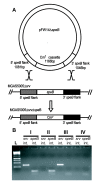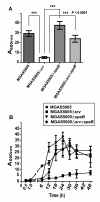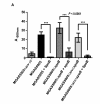Allelic replacement of the streptococcal cysteine protease SpeB in a Δsrv mutant background restores biofilm formation
- PMID: 21050462
- PMCID: PMC2992062
- DOI: 10.1186/1756-0500-3-281
Allelic replacement of the streptococcal cysteine protease SpeB in a Δsrv mutant background restores biofilm formation
Abstract
Background: Group A Streptococcus (GAS) is a Gram-positive human pathogen that is capable of causing a wide spectrum of human disease. Thus, the organism has evolved to colonize a number of physiologically distinct host sites. One such mechanism to aid colonization is the formation of a biofilm. We have recently shown that inactivation of the streptococcal regulator of virulence (Srv), results in a mutant strain exhibiting a significant reduction in biofilm formation. Unlike the parental strain (MGAS5005), the streptococcal cysteine protease (SpeB) is constitutively produced by the srv mutant (MGAS5005Δsrv) suggesting Srv contributes to the control of SpeB production. Given that SpeB is a potent protease, we hypothesized that the biofilm deficient phenotype of the srv mutant was due to the constitutive production of SpeB. In support of this hypothesis, we have previously demonstrated that treating cultures with E64, a commercially available chemical inhibitor of cysteine proteases, restored the ability of MGAS5005Δsrv to form biofilms. Still, it was unclear if the loss of biofilm formation by MGAS5005Δsrv was due only to the constitutive production of SpeB or to other changes inherent in the srv mutant strain. To address this question, we constructed a ΔsrvΔspeB double mutant through allelic replacement (MGAS5005ΔsrvΔspeB) and tested its ability to form biofilms in vitro.
Findings: Allelic replacement of speB in the srv mutant background restored the ability of this strain to form biofilms under static and continuous flow conditions. Furthermore, addition of purified SpeB to actively growing wild-type cultures significantly inhibited biofilm formation.
Conclusions: The constitutive production of SpeB by the srv mutant strain is responsible for the significant reduction of biofilm formation previously observed. The double mutant supports a model by which Srv contributes to biofilm formation and/or dispersal through regulation of speB/SpeB.
Figures





Similar articles
-
Dispersal of Group A streptococcal biofilms by the cysteine protease SpeB leads to increased disease severity in a murine model.PLoS One. 2011 Apr 25;6(4):e18984. doi: 10.1371/journal.pone.0018984. PLoS One. 2011. PMID: 21547075 Free PMC article.
-
Biofilm formation by group A Streptococcus: a role for the streptococcal regulator of virulence (Srv) and streptococcal cysteine protease (SpeB).Microbiology (Reading). 2009 Jan;155(Pt 1):46-52. doi: 10.1099/mic.0.021048-0. Microbiology (Reading). 2009. PMID: 19118345 Free PMC article.
-
Srv mediated dispersal of streptococcal biofilms through SpeB is observed in CovRS+ strains.PLoS One. 2011;6(12):e28640. doi: 10.1371/journal.pone.0028640. Epub 2011 Dec 7. PLoS One. 2011. PMID: 22163320 Free PMC article.
-
From transcription to activation: how group A streptococcus, the flesh-eating pathogen, regulates SpeB cysteine protease production.Mol Microbiol. 2011 Aug;81(3):588-601. doi: 10.1111/j.1365-2958.2011.07709.x. Epub 2011 Jun 24. Mol Microbiol. 2011. PMID: 21707787 Review.
-
Effects of streptococcal pyrogenic exotoxin B on pathogenesis of Streptococcus pyogenes.J Formos Med Assoc. 2008 Sep;107(9):677-85. doi: 10.1016/S0929-6646(08)60112-6. J Formos Med Assoc. 2008. PMID: 18796357 Review.
Cited by
-
Dispersal of Group A streptococcal biofilms by the cysteine protease SpeB leads to increased disease severity in a murine model.PLoS One. 2011 Apr 25;6(4):e18984. doi: 10.1371/journal.pone.0018984. PLoS One. 2011. PMID: 21547075 Free PMC article.
-
Streptococcus pyogenes biofilms-formation, biology, and clinical relevance.Front Cell Infect Microbiol. 2015 Feb 11;5:15. doi: 10.3389/fcimb.2015.00015. eCollection 2015. Front Cell Infect Microbiol. 2015. PMID: 25717441 Free PMC article. Review.
-
Streptococcus pyogenes Capsule Promotes Microcolony-Independent Biofilm Formation.J Bacteriol. 2019 Aug 22;201(18):e00052-19. doi: 10.1128/JB.00052-19. Print 2019 Sep 15. J Bacteriol. 2019. PMID: 31085695 Free PMC article.
-
Copper Tolerance and Characterization of a Copper-Responsive Operon, copYAZ, in an M1T1 Clinical Strain of Streptococcus pyogenes.J Bacteriol. 2015 Aug 1;197(15):2580-92. doi: 10.1128/JB.00127-15. Epub 2015 May 26. J Bacteriol. 2015. PMID: 26013489 Free PMC article.
-
Strategy to combat biofilms: a focus on biofilm dispersal enzymes.NPJ Biofilms Microbiomes. 2023 Sep 7;9(1):63. doi: 10.1038/s41522-023-00427-y. NPJ Biofilms Microbiomes. 2023. PMID: 37679355 Free PMC article. Review.
References
LinkOut - more resources
Full Text Sources

